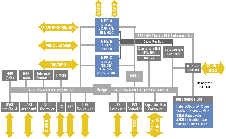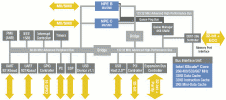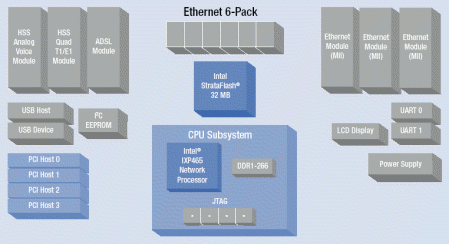New Intel SoCs target control and networking, run Linux
Oct 19, 2004 — by LinuxDevices Staff — from the LinuxDevices Archive — 1 viewsIntel is sampling two chips in a new ARM-based family of SoCs (system-on-chip) for network devices. The IXP46x family targets industrial automation, as well as communications and embedded networking devices for small-to-medium enterprises (SMEs). A development board and Linux support package (LSP) are available for the chips.
The two IXP46x family chips sampling now are the IXP460 and the IXP465. The IXP460 supports up to two 10/100 Ethernet MACs (with MII/SMII interface), whereas the IXP465 supports up to six 10/100 EMACs with SMII interface, or three with MII interface. The IXP460 also supports IEEE1588 hardware assistance for time synchronization in distributed control systems containing multiple clocks.
Like other members of Intel's XScale family, the new IXP46x chips include cores implemented by Intel based on an ISA (instruction set architecture) licensed from ARM, Ltd. The core in the IXP46x family includes 32KB each of data and instruction cache, along with a 2KB “mini-data” cache. It supports clock rates of 266, 400, 533, or 667MHz.
Both chips include a 32-bit 33/66 MHz PCI v2.2 bus, a USB v1.1 device controller, and a USB v. 2.0 host controller supporting low-speed and full-speed modes. Both support between 32MB and 1GB of DDR1-266 SDRAM, optionally ECC, through a 32-bit controller. A 32-bit expansion bus interface with parity offers glueless connection to “most other devices,” Intel says.


IXP465 (left) and IXP460 (right) function diagrams
(Click either to enlarge)
Additional features listed by Intel include:
- Up to six 10/100 Ethernet MACs with SMII interface, or three with MII interface
- UTOPIA-2 interface with multiple ADSL/G.SHDSL or VDSL PHY support
- Two HSS (high-speed serial) ports
- Silicon function assistance for random number generation
- Integrated hardware support for popular cryptography algorightms
- Hardware support for IEEE1588
- Two high-speed UARTs up to 921Kbaud each
- Integrated PC and SSP interfaces
- Spread spectrum clocking
- “Pre-validated, pre-integrated” Linux and VxWorks support packages
- 544-ball PBGA package
- 35 x 35, with 1.27mm ball pitch
- lead-free packages available
- 0 – 70 degree C and -40 – 85 C versions
IXDP465 development kit
Both the IXP460 and IXP465 are supported by the IXDP465 Development Platform, which includes a board, modules for LAN/WAN connectivity, and BSPs (board support packages) for Linux and VxWorks. Also included is IXP400 software, which runs on the XScale core to provide a “high-performance API” to on-chip network protocol accelerators — “network performance engines,” (NPEs) Intel calls them. Supplied “codelets” provide example usages of the XScale IXP400 APIs.

The development board has optional LAN/WAN modules
(Click to enlarge)
The IXDP465 includes a 533MHz IXP465 processor, along with DDR1-266 SDRAM and a JTAG connector. It also offers:
- Two USB connectors (one host, one device)
- Two UART connectors
- Four PCI host slots
- One PCI option connector
- I2C EEPROM
- 32MB Intel StrataFlash
- Six 10/100 Ethernet ports
- LCD display
LAN/WAN modules include:
- HSS analog (4-FXS, 1-FXO) voice module
- HSS quad T1/E1 module
- One ADSL or UTOPIA-2 module
- Three Ethernet MII modules
- Power-generation module
Doug Davis, GM of Intel's Infrastructure Process division, said, “The performance and flexibility of our network processor technology has become very attractive to new networking segments such as automation and control. Network processors are no longer just about relentless pursuit of line speed; they now need to combine more features and flexibility that allows customers to customize designs for their individual specifications.”
Availability
The IXP460 and IXP465 are sampling now, priced in 10K quantities at $19 to $75, depending on speed and temperature requirements.
This article was originally published on LinuxDevices.com and has been donated to the open source community by QuinStreet Inc. Please visit LinuxToday.com for up-to-date news and articles about Linux and open source.